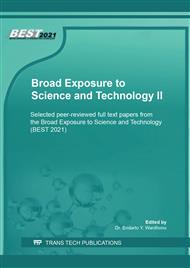[1]
A. Besinisc, S.D. Besinisc, H. Le, C. Tredwin, and R. Handy, Antibacterial activity and biofilm inhibition by surface modified titanium alloy medical implants following application ofsilver, titanium dioxide and hydroxyapatite nanocoatings Nanotoxicology 11(3) (2017), 327-338.
DOI: 10.1080/17435390.2017.1299890
Google Scholar
[2]
U. Danookdharree, H. Le, R. Handy, and C. Tredwin, Antibacterial coating made of strongly adhered nanosilver to titania nanotubes for dental implants (2015).
Google Scholar
[3]
G. Chi, S. Yao, J. Fan, W. Zhang, & H. Wang, Antibacterial activity of anodized aluminum with deposited silver. Surface and Coatings Technology (2002) 157(2-3), 162-165.
DOI: 10.1016/s0257-8972(02)00150-0
Google Scholar
[4]
H. Klasen, A historical review of the use of silver in the treatment of burns. II. Renewed interest for silver Burns, (2000) 26(2) 131-138.
DOI: 10.1016/s0305-4179(99)00116-3
Google Scholar
[5]
M. Hans, S. Mathews, F. Mücklich, and M. Solioz, Physicochemical properties of copper important for its antibacterial activity and development of a unified model Biointerphases, (2016) 11(1), 018902.
DOI: 10.1116/1.4935853
Google Scholar
[6]
S. Medici, M. Peana, V.M. Nurchi, J.I. Lachowicz, G. Crisponi, and M.A. Zoroddu, Noble metals in medicine: Latest advances.Coordination Chemistry Reviews, (2015) 284, 329-350.
DOI: 10.1016/j.ccr.2014.08.002
Google Scholar
[7]
A. Różańska, A. Chmielarczykc, D. Romaniszyn, A. Sroka-Oleksiak, M. Bulanda, M. Walkowicz, T. and Knych, Antimicrobial properties of selected copper alloys on Staphylococcus Aureus and Escherichia Coli in different simulations of environmental conditions: with vs. without organic contamination. International journal of environmental research and public health, (2017) 14(7), 813.
DOI: 10.3390/ijerph14070813
Google Scholar
[8]
H. Michels, S. Wilks, J. Noyce, C. and Keevil, Copper alloys for human infectious disease control Stainless steel (2005) 77000(55.0), 27.20.
Google Scholar
[9]
S. Heinonen, E. Huttunen-Saarivirta, J.P. Nikkanen, M. Raulio, O. Priha, J. Laakso, and E. Levänen, Antibacterial properties and chemical stability of superhydrophobic silver-containing surface produced by sol–gel route Colloids and Surfaces A: Physicochemical and Engineering Aspects 453, (2014) 149-161.
DOI: 10.1016/j.colsurfa.2014.04.037
Google Scholar
[10]
A. Tiwari, A. Chaturvedi, Antimicrobial coatings—Technology advancement or scientific myth. Handbook of Antimicrobial Coatings, (2018).
DOI: 10.1016/b978-0-12-811982-2.00001-9
Google Scholar
[11]
A.B. Monk, V. Kanmukhla, K. Trinder, and G. Borkow, Potent bactericidal efficacy of copper oxide impregnated non-porous solid surfaces BMC microbiology (2014) 14(1), 57.
DOI: 10.1186/1471-2180-14-57
Google Scholar
[12]
C.E. Santo, N. Taudte, D.H. Nies, and G. Grass, Contribution of copper ion resistance to survival of Escherichia coli on metallic copper surfaces. Appl. Environ. Microbiol., (2008) 74(4), 977-986.
DOI: 10.1128/aem.01938-07
Google Scholar
[13]
H.K Adrian, Pengaruh Variasi Konsentrasi 10-15% Larutan Asam Sulfat (H2SO4) Pada Proses Anodizing Aluminium Teknik Mesin, Universitas Sanata Dharma, Yogyakarta, (2017).
DOI: 10.30811/jmst.v4i1.1739
Google Scholar
[14]
Schlesinger M, Paunovic M 2011 Modern electroplating. John Wiley & Sons. Vol 55. (2011).
Google Scholar


